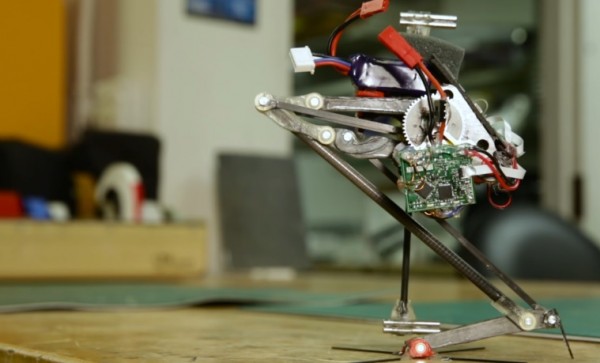By Ana Verayo, | December 07, 2016

Roboticists at UC Berkeley have designed a small robot with the highest robotic vertical jumping agility ever recorded. (UC Berkeley/YouTube)
Engineers have successfully created a vertically agile robot. Despite being small in size, this super robot can jump five times in a row and can bounce off a wall while jumping.
A team from the University of California, Berkeley took inspiration from an animal living in Africa, a primate similar to a lemur called the galago to create this new super-agile robot. This new robot possesses powerful legs specifically in the tendons that allow it to jump five times in four seconds at a whopping distance of 27.9 feet.
Like Us on Facebook
This powerful jumping robot is called Salto, which is short for "saltatorial locomotion on terrain obstacles." Scientists are hoping that this robot's vertical agility can greatly help in future emergency response and rescue missions during calamities, specifically scaling over piles of rubble.
To replicate the galagos' uncanny jumping abilities, the team created a new metric to measure Salto's jumps. Salto possesses a vertical agility of 5.7 feet for every second. This is a combination of the size of a single bound and how many times a single jump can be executed in a row. For example, a bullfrog's vertical agility is at 5.6 feet per second while the galago possesses an incredible 7.35 feet per second.
According to Duncan Haldane from UC Berkeley, by developing this new metric, it is possible to measure the vertical agility of Salto's unique design. This also helped the researchers to rank the jumping abilities of different animal species which can inspire future technological innovations.
Similar to the tiny galago, Salto crouches to store energy in its leg mechanism. This process is known as series-elastic power modulation. This motor spring action can store massive amounts of energy which is then released by Salto when it jumps. After a jump, this mechanism quickly reloads to replace it with new energy bursts, just in time when Salto lands.
This new study was published in the journal Science Robotics.
-
Use of Coronavirus Pandemic Drones Raises Privacy Concerns: Drones Spread Fear, Local Officials Say

-
Coronavirus Hampers The Delivery Of Lockheed Martin F-35 Stealth Fighters For 2020

-
Instagram Speeds Up Plans to Add Account Memorialization Feature Due to COVID-19 Deaths

-
NASA: Perseverance Plans to Bring 'Mars Rock' to Earth in 2031

-
600 Dead And 3,000 In The Hospital as Iranians Believed Drinking High-Concentrations of Alcohol Can Cure The Coronavirus

-
600 Dead And 3,000 In The Hospital as Iranians Believed Drinking High-Concentrations of Alcohol Can Cure The Coronavirus

-
COVID-19: Doctors, Nurses Use Virtual Reality to Learn New Skills in Treating Coronavirus Patients







